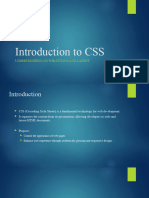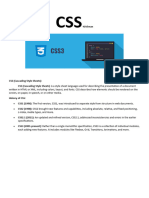0% found this document useful (0 votes)
51 views4 pagesCSS Basics For Beginners
This document is a beginner's guide to CSS, covering fundamental concepts such as styling HTML elements, the CSS Box Model, and modern layout techniques like Flexbox and Grid. It includes examples of CSS rules and selectors to illustrate how to apply styles effectively. The guide encourages continued practice and exploration of CSS to enhance web design skills.
Uploaded by
seongdarith123Copyright
© © All Rights Reserved
We take content rights seriously. If you suspect this is your content, claim it here.
Available Formats
Download as PDF, TXT or read online on Scribd
0% found this document useful (0 votes)
51 views4 pagesCSS Basics For Beginners
This document is a beginner's guide to CSS, covering fundamental concepts such as styling HTML elements, the CSS Box Model, and modern layout techniques like Flexbox and Grid. It includes examples of CSS rules and selectors to illustrate how to apply styles effectively. The guide encourages continued practice and exploration of CSS to enhance web design skills.
Uploaded by
seongdarith123Copyright
© © All Rights Reserved
We take content rights seriously. If you suspect this is your content, claim it here.
Available Formats
Download as PDF, TXT or read online on Scribd
/ 4


























































